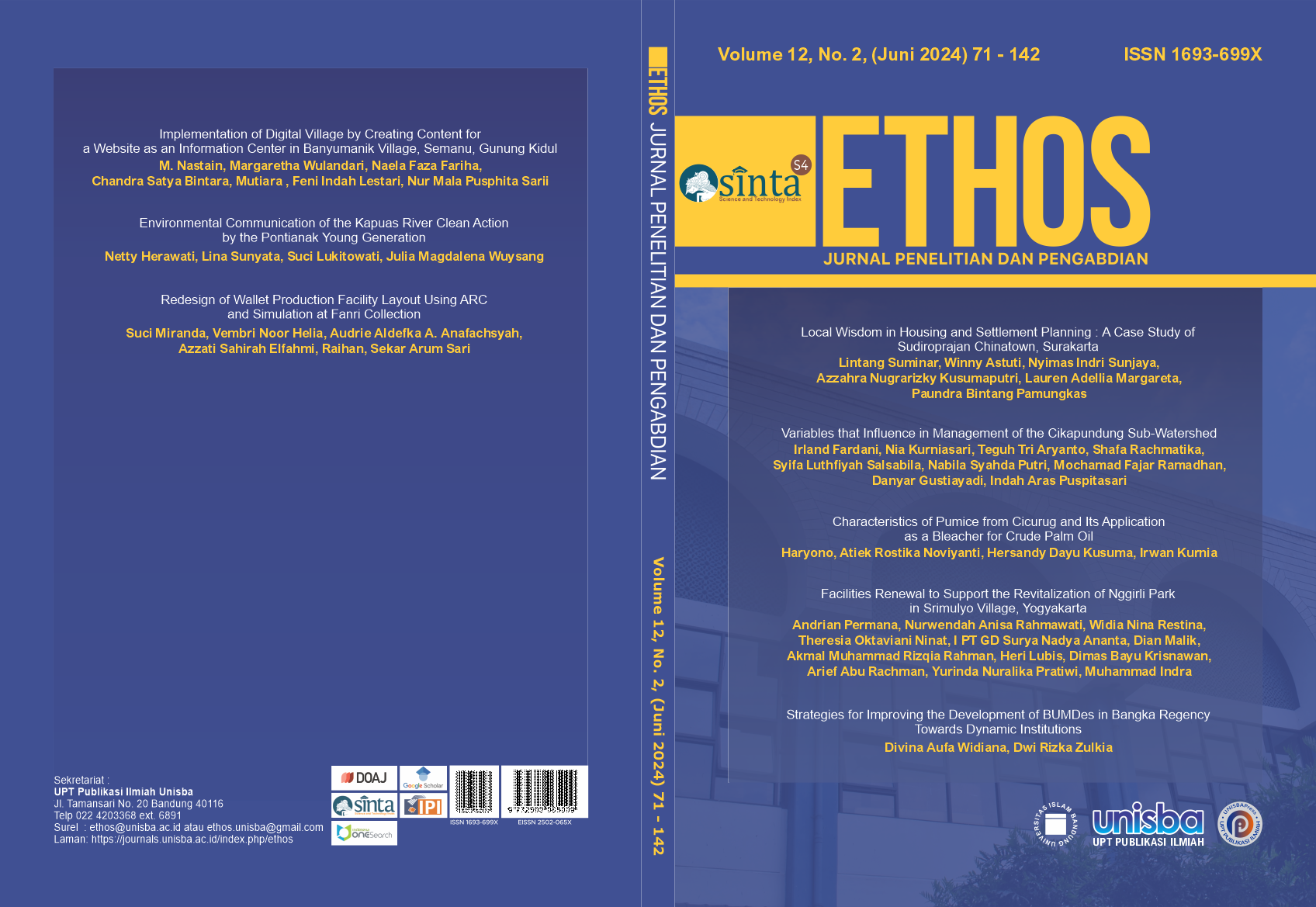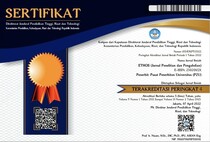Variables that Influence in Management of the Cikapundung Sub-Watershed
DOI:
https://doi.org/10.29313/ethos.v12i2.3404Keywords:
sub-watershed, cikapundung, important variabel, micmac analysisAbstract
The Cikapundung Sub-Watershed is a source of clean water for people living in Bandung City. The Cikapundung Sub-Watershed has several main problems, such as land change, landslides, and land damage. Many efforts have been made to improve the conditions of the Cikapundung sub-district by the government, the community, and Non-Governmental Organizations (NGOs). However, these efforts have not achieved satisfactory results. This occurs due to the inaccuracy of handling by each stakeholder regarding the variables that influence the conditions of the Cikapundung sub-district. This research aims to determine the variables that have the most influence on the management of the Cikapundung Sub-Watershed. This research uses Micmac analysis to identify the most influential variables within an ecosystem. From the research results, it appears that whether indirect influence or indirect influence, the variables of Society Participation and Local Wisdom are the most influential variables in the management of the Cikapundung sub-basin. These two variables are in a position that has a strong influence on other variables and has a low level of dependence on other variables.
References
Adysa, R., Suriadikusumah, A., & Arifin, M. (2023). Identifikasi Lahan Kritis Melalui Pemanfaatan Teknologi Drone Di DTA Cipaheut Pada SUB DAS Cikapundung Hulu. Sang Pencerah: Jurnal Ilmiah Universitas Muhammadiyah Buton, 9(2), 529–544. https://doi.org/10.35326/pencerah.v9i2.3170
Ankesa, H., Amanah, S., & Asngari, P. S. (2016). Partisipasi Kelompok Perempuan Peduli Lingkungan dalam Penanganan Sampah di Sub DAS Cikapundung, Provinsi Jawa Barat. Jurnal Penyuluhan, 12(2), 105–113.
Ariyani, D., Purwanto, M. Y. J., Sunarti, E., & Perdinan. (2022). Contributing factor influencing flood disaster using MICMAC (Ciliwung Watershed Case Study). Jurnal Pengelolaan Sumberdaya Alam Dan Lingkungan, 12(2), 268–280. https://doi.org/10.29244/jpsl.12.2.268-280
Ariyani, N., Ariyanti, D. O., & Ramadhan, M. (2020). Pengaturan Ideal tentang Pengelolaan Daerah Aliran Sungai di Indonesia ( Studi di Sungai Serang Kabupaten Kulon Progo ) ∗. Jurnal Hukum Ius Quia Iustum, 27(3), 592–614.
Astomo, P. (2020). Partisipasi Masyarakat Dalam Pengelolaan Daerah Aliran Sungai Mandar Berorientasi Lingkungan Hidup. Jurnal Mimbar Hukum, 33(1), 216–241. https://download.garuda.kemdikbud.go.id/article.php?article=2954077&val=26288&title=Partisipasi Masyarakat dalam Pengelolaan Daerah Aliran Sungai Mandar Berorientasi Lingkungan Hidup
Damayanti, V. (2019). Potensi Pengembangan Infrastruktur Hijau dalam Upaya Mewujudkan Cimahi sebagai Kota Hijau Berkelanjutan. ETHOS (Jurnal Penelitian Dan Pengabdian), 7(2), 233–243. https://doi.org/10.29313/ethos.v7i2.4560
Ekasari, A. M., Burhanudin, H., & Fardani, I. (2022). Analisis Kualitas Sub DAS Citarum Hulu. Media Komunikasi Geografi, 23(1), 44–57. https://doi.org/10.23887/mkg.v23i1.40612
Fardani, I., Kurniasari, N., Syaodih, E., Puspitasari Rochman, G., Pradifta, F. S., & A n i, T. a r l. (2023). Pendampingan Rencana Tata Ruang Desa (Rtrd) Berbasis Perencanaan Partisipatif. Jurnal Pengabdian Kepada Masyarakat Membangun Negeri, 7(2), 72–84. https://doi.org/10.35326/pkm.v7i2.3472
Fauzi, A. (2019). Teknik Analisis Keberlanjutan. In Jakarta (ID): PT. Gramedia Pustaka Utama. PT. Gramedia Pustaka Utama. https://books.google.com/books?hl=en&lr=&id=snKpDwAAQBAJ&oi=fnd&pg=PP1&dq=sampah+implementasi+formulasi+tantangan+pemerintah+kebijakan+strategi&ots=lCAE9LrUHp&sig=gTf3VG1HRBs5b_KsrZiBJtSQ9Do
Godet, M., & Roubelat, F. (1996). Creating the future: The use and misuse of scenarios. Long Range Planning, 29(2), 164–171. https://doi.org/https://doi.org/10.1016/0024-6301(96)00004-0
Husodo, T., Wulandari, I., Megantara, E. N., Shanida, S. S., Kuncoro, D. D., & Ratningsih, N. (2021). Partisipasi dan Persepsi Masyarakat Desa Cinunuk dalam Pengelolaan Sampah. ETHOS: Jurnal Penelitian Dan Pengabdian Kepada Masyarakat, 9(2), 192–203. https://doi.org/10.29313/ethos.v9i2.6984
Ishak, A., Fauzi, E., Firison, J., Miswarti, & Sastro, Y. (2021). Fading local wisdoms of upland rice varieties in situ conservation in South Bengkulu Regency (case in Pino Raya subdistrict). IOP Conference Series: Earth and Environmental Science, 733(1), 1–7. https://doi.org/10.1088/1755-1315/733/1/012031
Jaenudin Nurdiana, D. (2021). Social Capital dan Etika Lingkungan Dalam Komunitas Pemberdayaan Masyarakat Pada Wilayah Sungai Citarum. Coopetition : Jurnal Ilmiah Manajemen, 12(3), 373–380. https://doi.org/10.32670/coopetition.v12i3.713
Nopriani, M., Fauzi, A., & Nuva, N. (2022). Analisis Prospektif untuk Keberlanjutan Pengelolaan TPS 3R di Kota Pangkalpinang. Jurnal Pendidikan Tambusai, 6(3), 13791–13808. https://doi.org/10.31004/jptam.v6i3.4504
Nugroho, H. Y. S. H., Sallata, M. K., Allo, M. K., Wahyuningrum, N., Supangat, A. B., Setiawan, O., Njurumana, G. N., Isnan, W., Auliyani, D., Ansari, F., Hanindityasari, L., & Najib, N. N. (2023). Incorporating Traditional Knowledge into Science-Based Sociotechnical Measures in Upper Watershed Management: Theoretical Framework, Existing Practices and the Way Forward. Sustainability, 15(4). https://doi.org/10.3390/su15043502
Nugroho, S. P. (2003). Pergeseran kebijakan dan paradigma baru dalam pengelolaan daerah aliran sungai di indonesia. Jurnal Teknologi Lingkungan, 4(3), 136–142.
Rizka Maria, H. L. (2014). Pengaruh Penggunaan Lahan Terhadap Fungsi Konservasi Airtanah di Sub Das Cikapundung. Riset Geologi dan Pertambangan - Geology and Mining Research, 24(2), 77–89.
Sugandi, D., & Hamdanah, H. (2019). Effect of Forest Encroachment in Cisangkuy Sub Watershed. IOP Conference Series: Earth and Environmental Science, 286(1), 1–6. https://doi.org/10.1088/1755-1315/286/1/012025
Suhana, A. Y., & Hindersah, H. (2022). Penerapan Konsep Green infrastructure dalam Mencegah Erosi di Kawasan Sub DAS Cikapundung. Bandung Conference Series: Urban & Regional Planning, 2(2), 308–316.
Sulistyaningsih, T., Nurmandi, A., Salahudin, S., Roziqin, A., Kamil, M., Sihidi, I. T., Romadhan, A. A., & Loilatu, M. J. (2021). Public policy analysis on watershed governance in Indonesia. Sustainability (Switzerland), 13(12), 1–21. https://doi.org/10.3390/su13126615
Suryade, L., Fauzi, A., Achsani, N. A., & Anggraini, E. (2022). Variabel-Variabel Kunci dalam Pengembangan Kawasan Ekonomi Khusus Pariwisata ( KEK ) Berkelanjutan di Mandalika , Lombok Tengah , Indonesia. Jurnal Kepariwisataan: Destinasi, Hospitalitas dan Perjalanan, 6, 16–30. https://doi.org/10.34013/jk.v6i1.327
Sutrisna, N., Rahmat, A., Pengkajian, B., Pertanian, T., & Barat, J. (2012). Pemilihan Model Usaha Tani Konservasi Tanaman Sayuran Hulu Sub-Das Cikapundung, Bandung Utara Model Selection Of Vegetable Farm Conservation Sub-. Jurnal Pertanian Agros, 14(1), 114–124.
Syafri, S., Surya, B., Ridwan, R., Bahri, S., Rasyidi, E. S., & Sudarman, S. (2020). Water Quality Pollution Control and Watershed Management Based on Community Participation in Maros City, South Sulawesi, Indonesia. Sustainability, 12(24). https://doi.org/10.3390/su122410260
Downloads
Published
How to Cite
Issue
Section
License
Copyright (c) 2024 Irland Fardani, Nia Kurniasari, Teguh Tri Aryanto, Shafa Rachmatika, Syifa Luthfiyah Salsabila, Nabila Syahda Putri, Mochamad Fajar Ramadhan, Danyar Gustiayadi, Indah Aras Puspitasari

This work is licensed under a Creative Commons Attribution-NonCommercial-ShareAlike 4.0 International License.

















